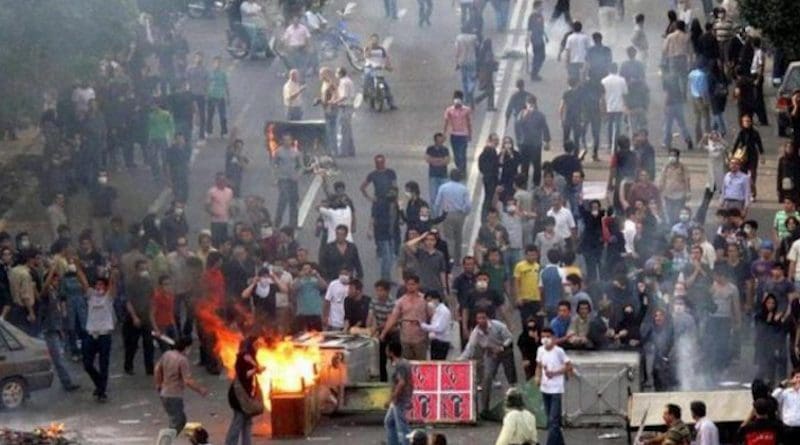Iran: Growing Protests A Thorn In Regime’s Side – OpEd
By Arab News
By Luke Coffey*
Protests in Iran’s southwest province of Khuzestan over the rising price of basic commodities have grown in frequency and size after a 10-story building collapsed in the city of Abadan, killing least 37 people. Protesters blame government corruption and shoddy construction work, and there is no sign that the protests will end in the near future.
So far, these protests are not on the same scale as the nationwide demonstrations in 2019. And while thelatest protests cause problems for the regime in Tehran — the Supreme Leader’s personal emissary was shouted down and silenced when he tried to address an angry crowd in Abadan last week — they are not existential. Many of the protesters are drawn from Iran’s small Arab Ahwaz minority, who resent the regime for treating them as second-class citizens, moving Persians and other non-Arab ethnic groups into their homeland.
Even though the spark that ignited the most recent flame in Khuzestan was the rise in food prices, what is playing out on the streets is longstanding resentment by the Ahwaz people toward Tehran. The region has been the focal point for anti-regime protests since last July when Tehran was accused of diverting scarce water resources to other regions.
Iran’s Ahwazis number about five million. While their plight may seem like a local issue, the international community should pay close attention. They live in two strategically important locations: Khuzestan province,which is home to Iran’s primary oil and natural gas production and major ports, and the Arabian Gulf region between Busher and Bandar Abbas, where there is significant maritime traffic. If these regions face disruption, the global economy could be negatively affected.
The situation in Khuzestan and the plight of the Ahwazis are a reminder that modern Iran is a collection of minority groups, each with its own history, culture, and language. Persians have dominated the ruling elite since the 1920s, so unless you speak Persian or have a Persian-sounding name, job prospects are limited in a country that suffers from high unemployment.
The repressive and ruthless regime in Tehran has violently suppressed many minority groups in recent years, with Persian elites displaying a willingness to wield a heavy hand against them. In 2019, for example, the regime even went so far as to deploy foreign Arab militias from Iraq and Lebanon, in addition to Revolutionary Guards and Basij militia, in response to popular unrest over Tehran’s neglectful handling of widespread flooding in Khuzestan.
The protests appear to be localized in Khuzestan, but there is a possibility that they could spread to other regions. According to social media reports, protests in solidarity with the Ahwaz community are planned for the ethnic Azeri cities in the north. The same thing happened last year when Ahwazis were protesting over water.
Some estimates claim that Azeris make up the second largest ethnic group in Iran, after Persians. There is a constant low-level push among the Azeri minority for self-determination and increased autonomy in northern Iran. If major protests were to break out in the north they would quickly become a major headache for the regime.
It is also important to see how Iran’s economic situation and social unrest may be linked to the talks in Viennaaimed at reviving the agreement to curb Iran’s nuclear program in return for lifting economic sanctions. Until now, US President Joe Biden has wanted a deal more than Iranian President Ebrahim Raisi. Knowing this, Raisi has been dragging out the talks to extract maximum concessions from the US. Now, however, that maybe changing.
European diplomats have described the talks as being at a “dead end.” The US does not trust Russia, a key player in the negotiations, because of the war in Ukraine. The US Congress has passed a bipartisan resolution warning the White House against agreeing to a nuclear deal weaker than the 2015 original. Important US midterm elections are coming up in November. Even though Biden made agreeing on a new nuclear deal with Iran a cornerstone of his foreign policy, he may now assess that an agreement on the terms Raisi would not be worth the domestic political price. All of this could mean a shift in the dynamics in Vienna, leading to Raisi wanting a deal more than Biden.
However, the Biden administration would be foolish to agree on a deal right now. Raisi is in a difficult spot domestically, and the US should walk away from the talks in Vienna until it is certain that it can achieve a deal stronger than the agreement it replaces.
While the protests in Iran may affect the dynamics of the talks in Vienna, they are unlikely to threaten the regime itself. Raisi, and those before him, have shown tremendous resilience in the face of popular unrest. The Green Movement protests more than a decade ago, and the nationwide protests in 2019, are good examples of this.
However, the situation for Raisi remains difficult. Since he came to power last August the economic situation remains bleak, with little hope of improvement in the short term.
Major protests across the country organized along ethnic lines are the last thing Raisi needs or wants.
• Luke Coffey is the director of the Douglas and Sarah Allison Center for Foreign Policy at the Heritage Foundation. Twitter: @LukeDCoffey

